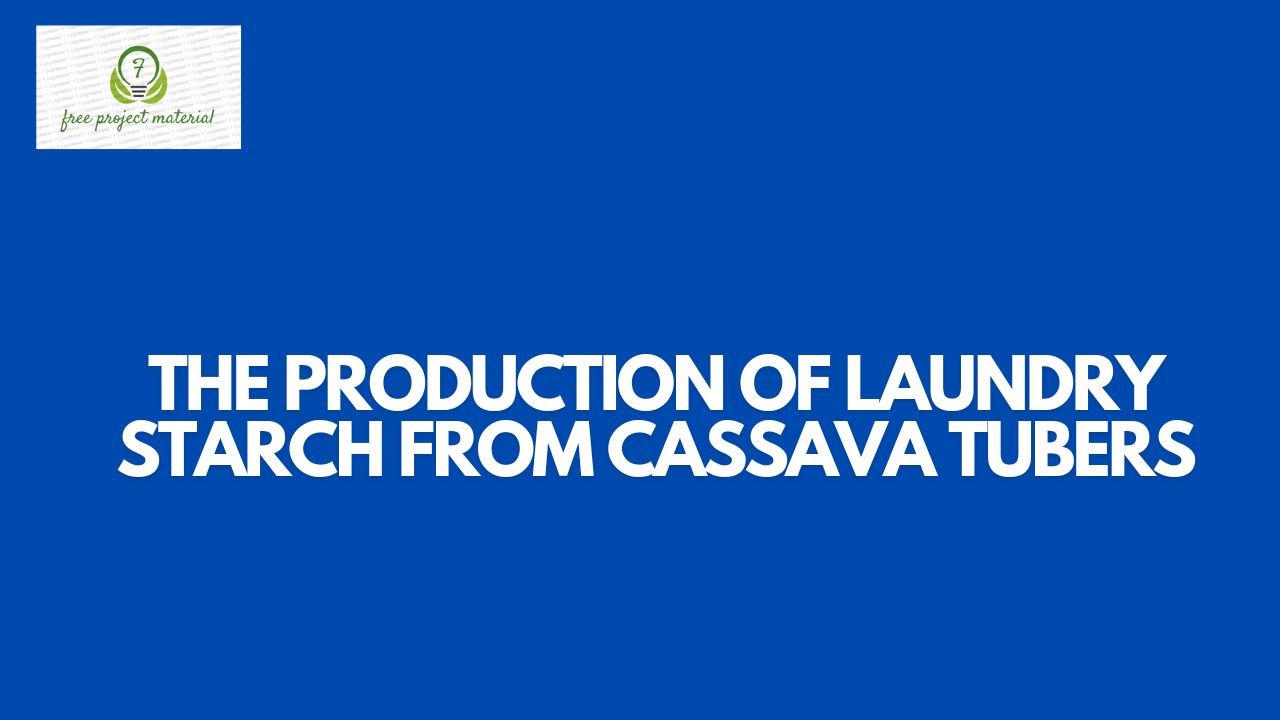ABSTRACT
The preparation characteristics of laundry starch using cassava tube was carried out using standard analytical procedure. The result reveals PH as 5.140, electrical conductivity 83.110 (NS/cm), Titratable acidity 33.806 (mg/l) and density 1.633 (g/cm3). However, this is work has given a first hand information on the quality of laundry starch produced using cassava tubes. Meanwhile, this product can be used for production and maintenance of fabrics.
TABLE OF CONTENTS
Certification – – – – – – – – i
Dedication – – – – – – – – – ii
Acknowledgment – – – – – – – – iii
Table of contents – – – – – – – – iv-viii
CHAPTER ONE: INTRODUCTION
1.1 Background of the Study – – – – – – 1-3
1.2 Aim and Objectives of the Study – – – – 3
1.3 Scope and Limitation of the Study – – – – 3
CHAPTER TWO: LITERATURE REVIEW
2.1 Cassava Products – – – – – – – 4-5
2.2 Utilization of Cassava Products in Nigeria – – – 5-6
2.3 Uses of Cassava as Food – – – – – – 7-10
2.4 Potential of Cassava as an Industrial Product – – 10-14
2.4.1 Cassava Use in Pharmaceuticals – – – – 14-15
2.4.2 Uses of Cassava in Animal Feed – – – – 15-16
2.4.3 Uses of Cassava in Food Manufacturing – – 16-17
2.4.4 Cassava as a Source of Foreign Exchange – – – 17-18
2.5 Cassava Product based on Starch – – – – 18-20
2.6 Cassava Starch Production Technology – – 20-21
2.6.1 Washing – – – – – – – – 22
2.6.2 Cutting and Rasping – – – – – – 23
2.6.3 Starch Extraction – – – – – – – 23-24
2.6.4 Sedimentation and Decanting – – – – – 24
2.6.5 Drying and Milling – – – – – – 24-25
CHAPTER THREE: MATERIALS AND METHOD
3.1 Materials – – – – – – – – 26
3.2 Sample Collection – – – – – – – 26
3.3. Sample Preparation – – – – – – 26-27
3.4 Method of Production of the Starch – – – – 28-29
CHAPTER FOUR: RESULTS AND DISCUSSION
4.1 Results – – – – – – – 30
4.2 Discussion – – – – – – – – 30-31
CHAPTER FIVE: CONCLUSION AND RECOMMENDATION
5.1 Conclusion – – – – – – – – 32
5.2 Recommendation – – – – – – – 32
References
CHAPTER ONE
INTRODUCTION
1.1 Background of the Study
Cassava belongs to the family euphorbiacae and it is claimed to have originated from the lattin Americans and Cultivated in almost all parts of the world with Nigeria as the highest cultivator of the root is estimated to be 184 million tonnes in 2002; it rose to 230 million tonnes in 2008 while Nigeria is the world’s largest producers of root cassava with an annual production of over 34 million tomes.
In all places, cassava has become very popular as a food and cash crop and is fast replacing yam and other traditional staple of the area. Cassava is important not just as food crop but even more as a major source of income for rural households, foreign exchange earner for the country, raw material for industries such as the alcohol and pharmaceutical industries. FAO (2007) revealed that about 42% of harvested cassava roots in West and East Africa are processed into dried clip and flour while Ajibola (2000) reported that Nigeria as the world’s largest exporting country of dried cassava with a total of 77% of world’s export in 2005. Thus, many Nigerians derive much of their food and employment from cassava production marketing and cassava based agro-industrial schemes.
IFAD and the FAO (2000), have found cassava to be used to alleviate food insecurity, especially in times of war or social unrest, as the crop is easy to grow, can be stored for long periods of time in the ground and also can be harvested at any period of the year. The economic potential of cassava cannot be matured by any other known crop, however the potential of cassava as an industrial raw material for various industries in Nigeria has not been exploited.
Starch is the major food preserve of cassava. It is approximately 21.3% of fresh cassava tube (IITA 1990). Like CF, cassava starch (cs) is prepared from either wet mash or dry chips. Starch extraction is easier and economical with wet mash. It also gives consistent and better quality starch. Particle size from dry milling of chips are highly variable with very fine and coarse materials resulting in constant clogging of the sieve aperture during washing of flour to obtain starch. Also, large quantity of water is necessary to drive the material through the sieve.
Since quality is of paramount important in starch trading, extraction from wet mash is often preferred in commercial starch extraction, because of control over product quality.
1.2 Aim and Objectives of the Study
The aim of this study is to determine the production of laundary starch from cassava tubers.
Objectives
- The objectives of this study are:
- To produce starch from cassava tubers
- To determine the chemical characteristics of the produced soap
- To make useful recommendation based on the result of this study.
1.3 Scope and Limitation of the Study
This study will only cover the production of laundry starch from cassava tubers, this is due to financial and time constraint.


